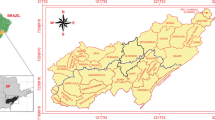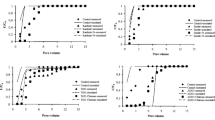Abstract
This paper presents the feasibility study on utilization of locally available clayey soil as a compacted clay liner based on its contaminant adsorption capacity under the presence of organic chemical Ethylene Diamine Tetra-acetic Acid (EDTA) which is abundantly released into the environment. Lead ion was selected as a contaminant and its adsorption by the soil was assessed by conducting batch sorption experiments with lead solution, presence of organic chemical EDTA with varying pH and concentration of lead. From this study, it was observed that, with an increase in the concentration of lead (from 10 to 30 mg/L), percentage adsorption of lead by soil was observed to be decreased with increase in initial concentration and percentage of absorption was increased with increase in the pH of the solution. With the presence of EDTA at pH 7, the percentage adsorption of lead by the soil decreased due to the formation of PbEDTA2− complex. This study shows that locally available clayey soil can be used as a compacted liner, where presence of EDTA is assured.
Access this chapter
Tax calculation will be finalised at checkout
Purchases are for personal use only
Similar content being viewed by others
References
Abdel-Halim, S. H., Shehata, A. M. A., & El-Shahat, M. F. (2003). Removal of lead ions from industrial waste water by different types of natural materials. Water Research, 37(7), 1678–1683.
Abollino, O., Acceto, M., Malandrino, M., Sarzanini, C., & Mentasi, E. (2003). Adsorption of heavy metals on Na-montmorillonite. Effect of pH and organic substances. Water Research, 37(7), 1619–1627.
Appel, C., & Lena, M. (1997). Concentration, pH, and surface charge effects on cadmium and lead sorption in three tropical soils. Journal of Environment, 31, 581–589.
Arnepalli, D. N., Hanumantha Rao, B., & Shanthakumar, S. (2010). Determination of distribution coefficient of geomaterials and immobilizing agents. Canadian Geotechnical Journal, 47(10), 1139–1148.
ASTM D 4646. (2008). Standard test method for 24-h batch-type measurement of contaminant sorption by. Distribution, 3(Reapproved 2008): pp. 3–6.
Bellir, K., Bencheikh-Lehocine, M., Meniai, A., & Gherbi, N. (2005). Study of the adsorption of heavy metals by natural material used as liners in landfills. Desalination, 185(1–3), 111–119.
Bourliva, A., Michailidis, K., Sikalidis, C., Filippidis, A., & Betsiou, M. (2013). Lead removal from aqueous solutions by natural Greek bentonites. Clay Minerals, 48(5), 771–787.
Bowers, A. R., & Huang, C. P. (1986). Adsorption characteristics of metal-EDTA complexes onto hydrous oxides. Journal of Colloid and Interface Science, 110(2), 575–590.
Cerqueira, B., Covelo, E., Andrade, M., & Vega, F. A. (2011). Adsorption and mobility of copper and lead in soils as influenced by soil horizon properties. Pedosphere, 21(5), 603–614.
Chen, S. S., Hsu, H. D., Lin, Y. J., & Chin, P. Y. (2008). Removal of EDTA from low pH printed-circuit board wastewater in a fluidized zero valent Iron reactor. Water Science and Technology, 58(3), 661–667.
Cherian, C., & Arnepalli, D. N. (2015). A critical appraisal of the role of clay mineralogy in lime Stabilization. International Journal of Geosynthetics and Ground Engineering, 1, 8.
David, E. D. (1993). Geotechnical practice for waste disposal (p. 1993). London: Chapman and Hall.
Demirbas, A. (2008). Heavy metal adsorption onto agro-based waste materials: A review. Journal of Hazardous Materials, 157(2–3), 220–229.
Dube, A., Zbytniewski, R., Kowalkowski, T., Cukrowska, E., & Buszewski, B. (2001). Adsorption and migration of heavy metals in soil. Polish Journal of Environmental Studies, 10(1), 1–10.
Farrah, H., & Pickering, W. F. (1977). The sorption of lead and cadmium species by clay minerals. Australian Journal of Chemistry, 30(7), 1417–1422.
Ghosh, S., Mukherjee, S., Al-Hamdan, A. Z., & Reddy, K. R. (2013). Efficacy of fine-grained soil as landfill liner material for containment of chrome tannery sludge. Geotechnical and Geological Engineering, 31, 493–500.
Gillman, G. P. (1979). A proposed method for the measurement of exchange properties of highly weathered soils. Austratian Journal of Soil Research, 17, 129–139.
Hamadneh, I., Abu-Zurayk, R., Abu-Irmaileh, B., Bozeya, A., & Al-Dujaili, A. H. (2015). Adsorption of Pb(II) on raw and organically modified Jordanian bentonite. Clay Minerals, 50(4), 485–496.
Hamdan, A. Z., & Reddy, K. R. (2006). Adsorption of heavy metals in glacial till soil. Geotechnical and Geological Engineering, 24, 1679–1693.
Ikhtiyarova, G. A., Ozcan, A. S., Gok, O., & Ozcan, A. (2012). Characterization of natural- and organo-bentonite by XRD, SEM, FTIR and thermal analysis techniques and its adsorption behaviour in aqueous solutions. Clay Minerals, 47, 31–44.
IS 2720-XXIV. (2010). Indian standard methods of test for soils (IS: 2720 (Part XXIV)—1976 (Reaffirmed 2010)). pp. 1–11.
Kumar, P. R., & Singh, D. N. (2005). A novel technique for monitoring contaminant transport through soils. Environmental Monitoring and Assessment, 109(1–3), 147–160.
dos Leticia, S. M., Fernanda, P. M., & Giulliana, M. (2014). Batch test methodology applied at a site contamianted with hexachlorocyclohexane. Environmetal Geotechnics, 2(6), 371–381.
Mbaye, A., Diop, C. A. K., Miehe-Brendle, J., Senocg, F., & Maury, F. (2014). Characterization of natural and chemically modified kaolinite from Mako (Senegal) to remove lead from aqueous solutions. Clay Minerals, 49(4), 527–539.
Moghimi, A. H., Hamdan, J., Shamshuddin, J., Samsuri, A. W., & Abtahi, A. (2013). Physicochemical properties and surface charge characteristics of arid soils in southeastern Iran. Applied and Environmental Soil Science.
Mohamed, A. M. O., & Antia, H. E. (1998). Geoenvironmental engineering (vol. 82). The Netherlands: Elsevier Science.
Mohamedzein, Y., Al-Rawas, A. A., Al-Aghbari Mohammad, Y., Ahmed, Q., & Abdul-Hamid, A.-R. (2005). Assessment of crushed shales for use as compacted landfill liners. Engineering Geology, 80(3–4), 271–281.
Naidu, R., Bolan, N. S., Kookana, R. S., & Tiller, K. G. (1994). Ionic-strength and pH effects on the adsorption of cadmium and the surface charge of soils. European Journal of Soil Science, 45, 419–429.
Naidu, R., Sumner, M., & Harter, R. (1998). Sorption of heavy metals in strongly weathered soils: An overview. Environmental Geochemistry and Health, 20, 5–9.
Nascentes, R., Christina, I., & Azevedo, D. D. (2011). Variation in hydraulic conductivity by the mobility of heavy metals in a compacted residual soil, hydraulic conductivity issues, determination and applications. In L. Enlango (Ed.). In Tech, ISBN: 978-953-307-288-3. Available from: http://www.intechopen.com/books/hydraulic-conductivity-issues-determination-and-applications/variation-in-hydraulic-conductivity-by-the-mobility-of-heavy-metals-in-a-compacted-residual-soil.
Nithya, K. M., Arnepalli, D. N., & Gandhi, S. R. (2016). Role of sorption characteristics of geomaterials on long term performance of landfill barrier role of sorption characteristics of geomaterials on long term performance of landfill barrier. International Journal of Soft Computing and Engineering, 2(5), 77–86.
Oviedo, C., & Rodríguez, J. (2003). EDTA: The chelating agent under environmental scrutiny. Quimica Nova, 26(6), 901–905.
Pandey, P. K., Sharma, S. K., & Sambi, S. S. (2010). Kinetics and equilibrium study of chromium adsorption on zeoliteNaX. 7(2), 395–404.
Pathak, P., Singh, D. N., Pandit, G. G., & Rakesh, R. R. (2016). Guidelines for quantification of geomaterial-contaminant interaction. Journal of Hazardous, Toxic, and Radioactive Waste, 20(1).
Peters, R. W. (1999). Chelant extraction of heavy metals from contaminated soils. Journal of Hazardous Materials, 66(1–2), 151–210.
Peters, R. W., & Shem, L. (1992). Adsorption/desorption characteristics of lead on various types of soil. Environmental Progress and Sustainable Energy, 11(3), 234–240.
Pickering, W. F. (1986). Metal ion speciation -soils and sediments. Ore Geology Reviews, 1, 83–146.
Reddy, K. R., Danda, S., Yukselen-Aksoy, Y., & Al-Hamdan, A. Z. (2010). Sequestration of heavy metals in soils from two polluted industrial sites: Implications for remediation. Land Contamination and Reclamation, 18(1), 13–23.
Reddy, K. R., Chaparro, C., & Saichek, R. E. (2003). Removal of mercury from clayey soils using electrokinetics. Part A, Toxic/Hazardous Substances and Environmental Engineering, Journal of Environmental Science and Health, 38(2), 307–338.
Reddy, K. R., Xie, T., & Dastgheibi, S. (2014). Nutrients removal from Urban stormwater by different filter materials. Water, Air, and Soil Pollution 225.
Robert, W. P., & Shem, L. (1992). Use of chelating agents for remediation of heavy metal contaminated soil. In Environmental remediation, ACS symposium series (vol. 509, pp. 70–84).
Robles, I., Serrano, T., Perez, J. J., Hernandez, G., Solis, S., Garcia, R., et al. (2014). Influence of EDTA on the electrochemical removal of mercury (II) in soil from san Joaquin, Queretaro, Mexico. Journal of the Mexican Chemical Society, 58(3), 332–338.
Rowe, R. K. (2012). Third Indian geotechnical society: Ferroco Terzaghi Oration design and construction of barrier systems to minimize environmental impacts due to municipal solid waste leachate and gas. Indian Geotechnical Journal, 42(4), 223–256.
Rowe, R. K. (2014). Performance of GCLS in liners for landfill and miming applications. Environmental Geotechnics, 1(1), 3–21.
Saada, A., Gaboriau, H., Cornu, S., Bardot, F., Villieras, F., & Croue, J. P. (2003). Adsorption of humic acid onto a kaolinitic clay studied by high-resolution argon adsorption volumetry. Clay Minerals, 38(4), 433–443.
Shackelford, C. D., & Daniel, D. E. (1991). Diffusion in saturated soil. I: Background. Journal of Geotechnical Engineering, 117(3), 467–484.
Viraraghavan, T., & Dronamraju, M. M. (1993). Removal of copper, nickel and zinc from wastewater by adsorption using peat. Part A Environmental Science and Engineering, Journal of Environmental Science and Health, 28(6), 1261–1276.
Vohra, M. S. (2010). Adsorption of lead, Ethylene Diamine Tetra acetic acid and Lead-Ethylene diamine tetra acetic acid complex onto granular activated carbon. International Journal of Environmental Science and Technology, 7(4), 687–696.
Author information
Authors and Affiliations
Corresponding author
Editor information
Editors and Affiliations
Rights and permissions
Copyright information
© 2020 Springer Nature Singapore Pte Ltd.
About this paper
Cite this paper
Yantrapalli, S., Hari Krishna, P. (2020). A Study on Influence of Organic Ligand on the Adsorption of Lead by Clayey Soil. In: Saride, S., Umashankar, B., Avirneni, D. (eds) Advances in Geotechnical and Transportation Engineering . Lecture Notes in Civil Engineering, vol 71. Springer, Singapore. https://doi.org/10.1007/978-981-15-3662-5_25
Download citation
DOI: https://doi.org/10.1007/978-981-15-3662-5_25
Published:
Publisher Name: Springer, Singapore
Print ISBN: 978-981-15-3661-8
Online ISBN: 978-981-15-3662-5
eBook Packages: EngineeringEngineering (R0)




